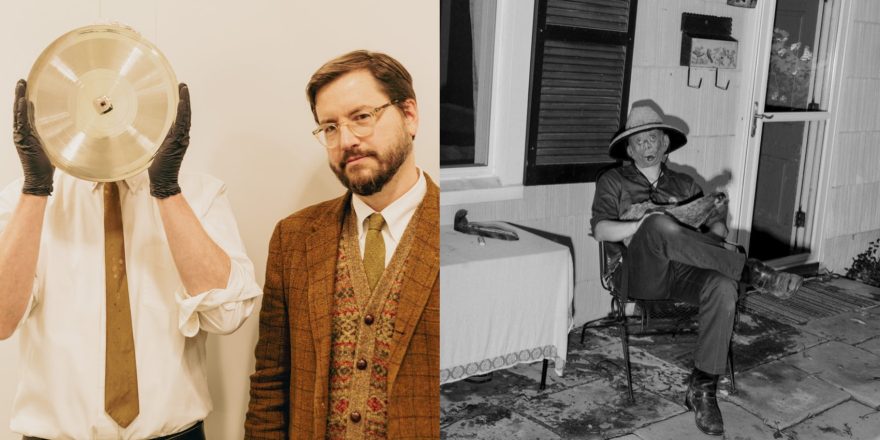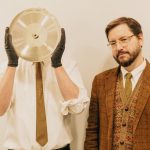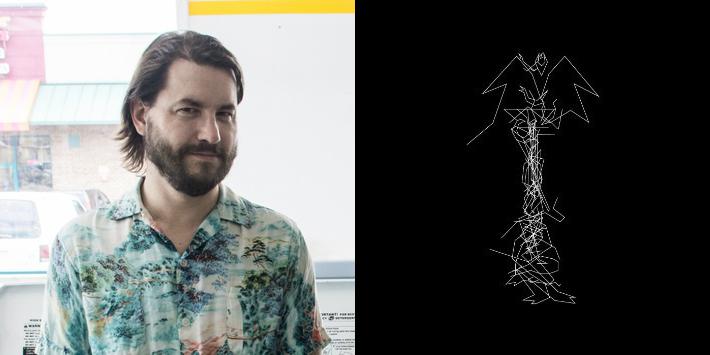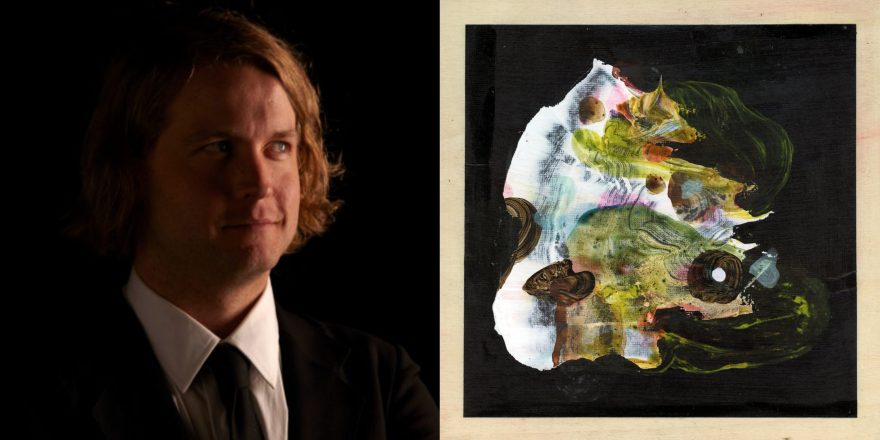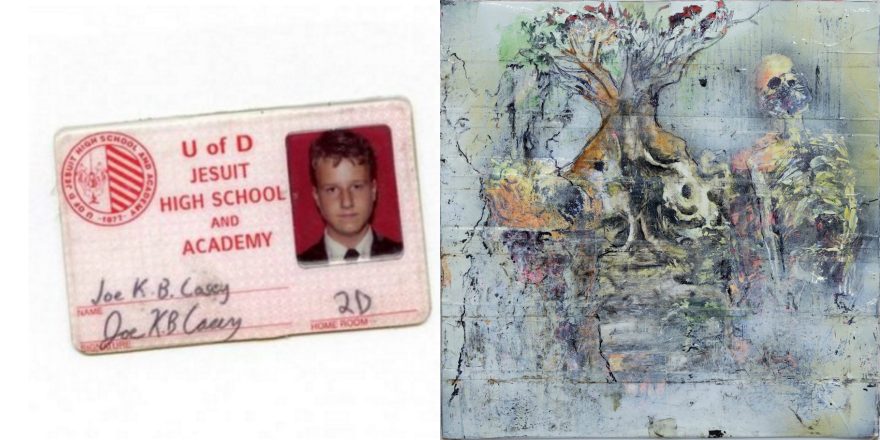Aaron Dilloway is an Ohio-based experimental musician, and a founding member of the legendary noise band Wolf Eyes; Martin C. Schmidt and Drew Daniel are the Baltimore-based electronic duo Matmos. Matmos just put out their record Return to Archive — a project in collaboration with the Smithsonian’s Folkways Records, made entirely from sampling “non-music” albums in the label’s catalog in honor of its 75th anniversary. Aaron contributed to the record, so to celebrate its release, the three got on a Zoom call to catch up about it, and much more.
— Annie Fell, Editor-in-chief, Talkhouse Music
Aaron Dilloway: Hey, Martin.
Martin C. Schmidt: Hi! What’s the Malcolm McDowell collage behind you?
Aaron: Oh, that’s a Japanese poster for O Lucky Man!.
Martin: That’s the poster? I totally thought it was a collage.
Drew Daniel: I like the shattering of the face. So, I wanted to ask you, Aaron, about that Bhoot Ghar field recording of the haunted house.
Aaron: Oh, yeah.
Drew: It’s a really fun experience to hear it as audio, so I wonder if I’m maybe going to shatter the illusion, but what does it look like? What are you seeing? And what are you reacting to? Because hearing the laughter and then the screams across different tracks… Tell me more. What are the scary things that happen inside the Bhoot Ghar haunted house?
Aaron: I mean, the scariest thing is that most of it is just pitch black. You’re going through a pitch black wooden maze and bumping into walls, and occasionally there’ll be some things — one room is completely empty except for an old desk and a basket, and you’ll knock into that. That’s mostly what it is. And you’ll hear things happen in the distance, but you can’t really tell because it’s a maze and you don’t know where things are going to pop out. And then occasionally things will pop out, these kind of really raw animatronics — they’re really crude, really rusted, and just gross. Clothes spray painted with red blood and ripped up rubber masks stuck over top of old mannequins. And there’s only maybe four or five different monsters that pop out, but it’s all sensors, so when you walk by a spot it’ll pop out.
Martin: That sounds terrifying and hilarious.
Aaron: Yeah. No one’s ever cleaned it or updated anything about this place since, like, 1983.
Drew: I was struck by the English, too. How much English literacy is there? Or is it just obvious from the sound of that voice that this is spooky stuff? You know, “Welcome foolish mortals…”
Aaron: Well, some of that is actually from a Disney record.
Martin: Yeah, I recognize the voiceover guy.
Aaron: Yeah, so it’s a collage someone made. The first track on it is the entrance music — I think it’s around seven minutes long — that plays as you’re walking in there. I just sat by the speaker. It’s coming out of a speaker they probably bought 20 years ago, and half the sound blows out at a couple points and you just hear, like, a ripping speaker. But it’s this rude sound collage. Part of the one of the tracks my Indian friend said was from their ‘90s version of The Twilight Zone in India. The theme song for that’s in there, and some other sound effects.
Drew: Yeah. I loved hearing your family’s reactions. I’m assuming it was your kids there? Who’s laughing?
Aaron: There’s one walk through that is me and my kids’ mother, Erika, and then a Nepali couple. The woman who’s screaming a bunch is this Nepali girl that we were walking through with. And then the second walk through I do is with my son, and we’re just kind of giggling the whole time. But I really love the one with — the woman was so scared. [Laughs.]
Drew: Yeah. I mean, in some ways, it leads into a lot of what I see in your work, which is this strange leveraging of “comedy times noise equals what?” From the use of of titles that have the words “jester” or “gag” or “in stitches,” there’s this constant frame of the comedic. But then the actual experience is a lot more threatening, or just mysterious. What’s up with comedy? What does comedy and sound mean to you?
Aaron: Well, I mean, I love to laugh. I like funny stuff, and I like horror movies. It’s a lot easier to laugh at horror when you know it’s not real. So, you know… I don’t know what I’m trying to get at.
Martin: Well, it was a torturous question, and I blame Drew.
Drew: [Laughs.] Sorry, I’m being pretentious. I guess when I think of a stereotype about noise and power electronics, it’s often that there’s an attempt to be edgy and threatening, with respect to content about fascism or murder.
Martin: Or there was.
Drew: Or there was in the ‘70s and ‘80s. And I wonder if there isn’t a kind of implicit de-dramatizing of what noise is about when you engage with the threatening in the work, and yet it’s also so silly in certain respects. Not that you’re unserious, but it’s a different attitude about what noise means or what it could mean.
Aaron: Yeah. I mean, it also depends on your frame of mind while you’re listening to it. And that goes for me too. I mean, there’s been times when I’m recording something or playing a show where I can scare myself, or there’s times doing the exact same thing when something will happen and it’ll crack me up — maybe even the same sound in a different context.
Drew: So when you were performing with the chickens—
Martin: [Laughs.] Scary, or funny?
Drew: I feel like that rescued a lot of people from quarantine doldrums. There had been so much separation and loneliness. So a lot of cool perform-online series popped up. But that Experimental Sound Studios series that was the host for the chicken performance — can you talk a little bit about setting it up, and what it felt like to play with chickens?
Aaron: I mean, they were what kept me sane. That was pretty early in the pandemic when we were all still like, “What’s really happening?” It was at the point where we were still cleaning off bags of potato chips. But I had chickens, and going out and sitting in my backyard watching them just kept me sane somehow. It was just very relaxing and meditative. It’s kind of like watching water, you know? They’re always just in constant motion. You never really know which way it’s going to go. I mean, I guess you can with water — bad comparison. But, so I had been actually bringing them into my studio and recording with them for about a week or two before that gig came up.
Martin: Like one at a time, or?
Aaron: There were two that I would bring in there, the two that most liked being held. They were the easiest to catch. [Laughs.]
Martin: Sure. And did you put them on a table or on the floor or…?
Aaron: I just let them have free reign in my studio. I had a piece of sheet metal and a guitar, and the guitar was running through this old Maestro guitar synthesizer. It was a guitar that had a broken neck, so I was just like, “Oh, I can throw some blueberries on that one, that’s OK.”
Drew: So you were leading them on a little bit, with rewards for music.
Aaron: Yeah, exactly.
Drew: I think that letting go of control that you’re describing might be why it was soothing to see. And maybe that gets to what I was saying before about [how] there’s an imagery of noise being about power or brutality. There wasn’t an ambient quality to the sound world that you made with the chickens, but it felt like an ambient situation of letting go of control and letting things unfold at their own pace that felt gentle, you know?
Aaron: Yeah. And I mean, given the history of noise and my more crazy live shows, there probably could have been people like, “What the fuck is he going to do with this chicken?” [Laughs.]
Drew: “Are you going to kill the chicken?”
Aaron: Yeah, exactly. But no, I loved my chickens.
Martin: Did a fox or a dog eat them?
Drew: What happened?
Aaron: We’ve got some sort of predators out there that have kind of picked them off over the years. I think at that point, I only had four left. And then when I went to Nepal, we gave the last two to my neighbor, and I guess they got they got killed maybe a month before we returned. So, yeah, I don’t have any right now.
Martin: We have a buddy here who kept ducks for years, and I didn’t get the impression it was ever for long.
Drew: Did you play the Chicken Traces record for the chickens? Did they ever experience their own artistic output?
Aaron: I mean, you don’t hear it that much on the video performance. But for Jon Abbey’s Erstwhile series — I originally recorded it for that, before the live performance, and there’s a little more of the chickens, the sound of their voices. And it was being looped, so they were hearing it in the room. They were hearing their own voices coming back at them.
Drew: You ever check out those Paul Panhuysen records with birds?
Aaron: Paul Panhuysen?
Drew: Yeah, he’s a Dutch avant garde composer. He sets up big environments that will have stringed resonating instruments inside them, and then lots of birds interacting with the instruments. Check it out, you might dig it.
Aaron: Yeah, for sure.
Drew: It might be something to get in the shop. So I was wondering as well about [how], now that you’re a parent, you’ve got a kid releasing music on Hanson. How do you avoid the stage parent trap? How do you oversee that without—
Martin: Maybe he’s not avoiding it, Drew. Maybe he’s going for it.
Aaron: [Laughs.] I’m letting him do what he wants. Actually, that tape isn’t on Hanson — it’s on his label, Elf Riot, which is actually a label I started when I was in ninth grade. It wasn’t real, but I made a lot of tape covers for it, and I made business cards. He’s got a whole set of business cards that have my parents’ old phone number on it.
Martin: [Laughs.] You turned that label over to him.
Aaron: He’s kind of gone on his own path checking stuff out, because he’s always on his phone and just digging. He’s turning me on to stuff that I’ve never heard.
Drew: Right on. Yeah, I remember hanging out with Mark Fell, and he was saying that his son was getting interested in electronic music but that he didn’t want his son to make any music with a laptop until he had learned how to properly program with MIDI. Then later, this amazing musician, Rian Treanor starts putting out records, and then it’s revealed Rian Treanor is Mark Fell’s kid. So it’s interesting to see generational stackings of this sort of work.
I wanted to ask you about the Sounds of the Junkyard record. When did you first hear it? What did you think of it?
Aaron: Well, I had to order it, because I had heard of it — I can’t remember where I heard of it, honestly, but it was probably mid-‘90s when I was living in a punk house. We were all working at a record shop and I remember it seemed like an impossible record to find. But you could order anything on Folkways from their website on cassette tape, so I ordered it on tape and it came in a nice clamshell case with the liner notes photocopied and folded up in there. I just thought it was incredible that this label would put something out like this, that a record like this would be made. But it goes back to me getting this record, Sounds of New Music, and that’s when I really discovered Folkways.
Martin: What’s on that?
Aaron: This has my favorite musical piece of all time, which is “Steel Foundry” by Alexander Mosolov. My friend Steve Kenny got this record and we were hanging out one night smoking tons of weed, and he pulled it out. It was the first time I saw people writing scores where it just looks like scribbles. I was looking at it, and this picture of Ussachevsky with these primitive electronics; I kind of put myself back in 1950 trying to imagine what it sounded like hearing this stuff, and I almost threw up. I was like, “This is way too intense.”
I started researching what exactly Folkways was, and they did everything — there’s Sounds of the Frogs and the Music of the Carousel, and it just blew my mind. I would grab any Folkways that I could find.
Drew: Yeah. The savagery and brutality of some of the audio is really startling, and you have to wonder, what did it sound like in 1951 to drop the needle and to hear something that’s just so bleary and puzzling and harsh? We got access to the Cook Records label and the Folkways—
Aaron: I was just going to bring up the Cook stuff — what’s the one, that In Fidelytie record?
Drew: Yeah, The Compleat In Fidelytie.
Aaron: Oh, man.
Drew: That side that’s “Wind in the Trees” for 20 minutes is so beautiful. It’s so mysterious.
Aaron: [Laughs.] That is truly noise music.
Drew: Yeah, I don’t understand it, because if you just described it as like, “Yeah, it’s wind in trees,” you might think, Oh, that’s banal. That’ll be the most boring thing ever. But it’s not. It really has this strange, incantatory presence, and you don’t know why. Plus, the Cook dude just seems like he was bananas. I mean, the liner notes, the titles of some of those tracks are just confounding.
Martin: He thinks he’s hilarious.
Drew: Yeah, there is this sort of self-bemused, maybe a little pretentious… But also the odd marketing of some of those Cook records — like, there’s one where there’s a white guy nerd in a white shirt and tie listening to a tape recorder while a sexy model looks at a hand puppet on her hand through this wire screen. [Cook’s Tour of High Fidelity.] It’s just a totally bizarre, very gendered scene of like, what am I about to hear? Yeah, those records are wild.
So how did you approach manipulating it for us? Because when we said, “Hey, will you do this?” You were in Nepal. So did you have — you don’t bring vinyl to Nepal, right?
Aaron: No, I downloaded it from the website.
Drew: But you had brought your rig…
Aaron: Yeah, I had my 8-track tapes. And I should say, a piece that’s on this Folkways Sounds of the New Music that’s really dear to my heart is the Henry Jacobs tape loop demonstration. That’s the one that really flipped me out, like people hearing this in 1953. They must have just thought this was alien music. And I just really fell in love with making tape loops, so I was so honored that you guys asked me to collaborate on this and go into the junkyard sounds and make my tape loops like I was Henry Jacobs making a record for Folkways.
Drew: It blows our mind, too, that we’re on Folkways. We kind of can’t believe it. It’s such a weird thing that I associate with the past, and yet it does still exist. And they’re very particular about the way that they do things — the entire production process is kind of a window into something that is maybe about Folkways, but maybe also about the fact that they’ve been acquired by the Smithsonian, so there’s this government archive bureaucracy dimension that I think is kind of nice, with the weirdness of like, what the fuck our actual music sounds like. [Laughs.]
Martin: Yeah. Like, had that not happened — had he not sold it to the Smithsonian — how fucking obscure would this shit be? There would only be the vinyl, and that would be that.
Drew: Collector nerds only.
Martin: Do you have the cassette that you ordered?
Aaron: Yeah, yeah, one of my prized possessions. It was so cool that you could just get everything.
Drew: Yeah, I think that was one of the best moments of fast talking, that Moses Asch convinced the US government to keep every single bizarre noise record he’d ever put out in print forever.
Martin: What a beautiful thing.
Aaron: Absolutely.
Drew: Well, thank you so much for being on our record. It was a huge honor to have you as a guest. We got Evicshen on side A and you’re on side B, so we got a sort of alpha-omega.
Aaron: [Laughs.]
Drew: We were super chuffed that you were down to do it, so thank you.



